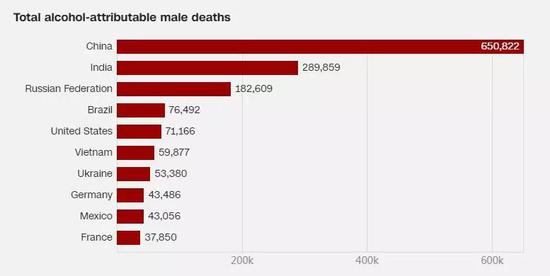In recent years, with the deepening of various types of research, people’s understanding of the dangers of alcohol has gradually become clear. For example, an article published in the Lancet earlier this year pointed out that after drinking more than a recommended amount of alcohol, life expectancy will be reduced by half an hour. The increase in the risk of cardiovascular diseases, cancer, and other diseases is gradually becoming known.
However, these scientific pieces of evidence still cannot stop a large number of alcohol lovers. One point they often quote is that the harm of alcohol to human health occurs only when the amount of alcohol exceeds a certain amount, and a small amount of drinking will not only cause any harm, moreover, also benefit cardiovascular health. However, a large-scale study just published in the authoritative medical journal The Lancet article completely denies this view. The study, which covers 28 million drinkers in 195 countries and regions, points out that there is no so-called “safe intake” in alcohol, and drinking is harmful to the body regardless of intake.

Biggest survey on Alcohol drinking
The data from this epidemiological study comes from the 2016 Global Burden of Disease Study (GBD), which investigates the social and health stresses of alcohol-borne illness, premature death, and disability. To this end, the research team analyzed 694 data on individual and population drinking, and 592 prospective and retrospective studies on drinking risk, ranging from drinkers aged 15 to 95, with a time span of up to 27 Year (1990~2016). This unprecedented scale of research has become the most comprehensive and reliable reference for us to understand alcohol health and social harm.
According to the data, in 2016, the number of people killed by alcohol worldwide reached 2.8 million. Alcohol has become the seventh leading cause of death and disability in the world. Even more worrisome is that alcohol problems are more severe in adolescents and middle-aged people. 12% of male deaths between the ages of 15 and 49 are directly related to alcohol, and drinking has become the leading cause of death in this age group.
Compared with these figures, people are more concerned about how alcohol affects the health and even life of people of different ages. Because alcohol affects human health in a more complex way, the research team considers up to 23 factors, including cardiovascular disease, cancer, other non-communicable diseases (such as diabetes, cirrhosis), infectious diseases (lower respiratory infections, tuberculosis), 7 categories of intentional injury, unintentional injury and traffic accidents. (For specific entries, see the end of the article)
As long as you drink alcohol, it is harmful.
The results showed that people who drank a glass of wine (10 grams of alcohol, equivalent to a can of beer, 100 milliliters of red wine or 30 milliliters of white wine) a day increased the risk of health problems by 0.5% compared to those who did not drink at all; When the daily drinking volume rose to 2 and 5 cups respectively, this figure rose rapidly to 7% and 37% respectively.
Specifically, for people aged 15 to 49, the main causes of alcohol-induced premature death include tuberculosis, traffic accidents, and self-harm; in people over the age of 50, cancer is the main cause of alcohol death.
The study did not completely deny the beneficial side of alcohol. However, only the preventive effect of alcohol on ischemic heart disease has been confirmed, and the role of diabetes and ischemic stroke is not supported by strong enough data. At the same time, as alcohol intake increases, the risk of other health problems increases significantly. Even if drinking has some benefits for cardiovascular, it is completely offset by other health risks. Therefore, there is no “safe dose” for alcohol intake.
“The urgent task at this moment is to completely modify the current alcohol policy to reduce people’s alcohol intake or to completely quit alcohol. It’s a misunderstanding that drinking 1~2 glasses of wine a day is good for health. Our Research has uncovered the truth,” said Emmanuela Gakidou of the University of Washington, one of the lead authors of the study. “Possible changes include taxing alcohol, controlling the way in which alcohol is purchased, selling time, and controlling alcohol advertising.” Actions will help reduce alcohol intake in the population, which can be an important means of reducing the health risks caused by alcohol.”
Where do people like to drink alcohol?
The study also analyzed drinking data from various countries and regions around the world and mapped the global alcohol intake map.

The data show that the countries with the highest proportion of drinking population and the highest amount of drinking are concentrated in Europe (especially Eastern Europe and Northern Europe). For example, Denmark has the highest proportion of people drinking alcohol. More than 95% of the population over 15 years old drink alcohol, while Romania and Ukraine respectively. It is the country with the highest alcohol consumption among men and women. In contrast, countries with the lowest alcohol consumption in the world are concentrated in the Middle East and North Africa.

In the statistics on the number of people killed by alcohol, although the per capita consumption of alcohol in China is not prominent, due to the population base, the number of people who die from alcohol in China ranks first in the world. In 2016 alone, more than 700,000 deaths in China were directly related to alcohol, much higher than India (330,000) and Russia (220,000) ranked second and third.


The research team said that although their data reveals a huge health hazard to alcohol, it is not a complete consequence – the risk of alcohol is likely to be significantly underestimated. For example, the study did not consider illegal alcohol intake, drinking in children under 15 years of age, and the effects of alcohol on diseases such as dementia. In addition, data on alcohol-induced violence and traffic accidents are not perfect. As the research progresses, the health effects of alcohol will be even more shocking.
Robyn Burton of King’s College London pointed out in his comments: “The study yielded a clear and irrefutable conclusion: Alcohol has become a huge global health problem, and the small health benefits of a small amount of alcohol cannot offset it. Other health risks (such as cancer) have improved.”
Consequences of alcohol drinking
- Cardiovascular disease: atrial fibrillation, hemorrhagic stroke, ischemic stroke, hypertensive heart disease, ischemic heart disease, alcoholic cardiomyopathy;
- Cancer: breast cancer, colon cancer, liver cancer, esophageal cancer, laryngeal cancer, oral cancer, nasal cancer;
- Other non-communicable diseases: cirrhosis, diabetes, epilepsy, pancreatitis, alcohol use disorders;
- Infectious diseases: lower respiratory tract infections, tuberculosis;
- Intentional injury (including interpersonal violence, self-harm);
- Inadvertent injury (including mechanical injury, poisoning, drowning, burns, etc.);
- Traffic damage.
Original/ Source / via: tech.sina.com.cn/d/v/2018-08-28/doc-ihifuvpi1478542.shtml
Related Posts
Interior Tips for a Wellness Home – Why Wellness Features Are a Pivotal Factor Post-Pandemic
Transforming Mental Health with Best AI-based Apps
Top 8 Healthcare Devices that everyone must have right now
Interview with Mr. Sagar M Verma, Co-Founder – Myhealthadvisor
Steps to Consider when Buying Health Insurance Plan for Coronavirus
Technology: The New Normal in India’s Healthcare sector